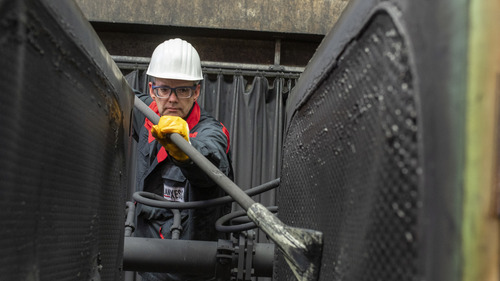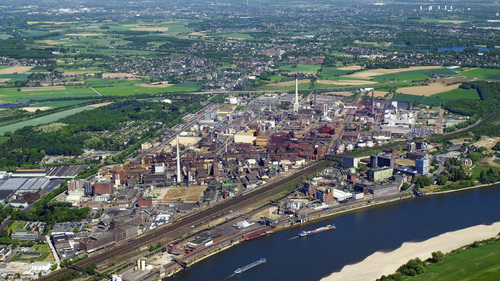LANXESS increases black pigment capacity in Krefeld-Uerdingen, Germany
COLOGNE-LANXESS is continuing the systematic expansion of its production for synthetic iron oxide pigments. The company is the only supplier worldwide to produce these pigments using the Laux process.
Specialty chemicals company LANXESS has expanded its capacity for black synthetic iron oxide pigments at its Krefeld-Uerdingen site by more than 5,000 metric tons per year. “The increased demand from the construction industry, in particular for our unique black pigments to color concrete, can be even better met with the debottlenecking measures that have now been completed,” says Holger Hüppeler, head of the Inorganic Pigments business unit at LANXESS. The company is thus continuing the systematic expansion of its production capacities for synthetic iron oxide pigments. LANXESS is the only supplier worldwide to produce these pigments using the Laux process.
Black is trending
In architecture and landscaping, the black coloration of concrete has been a trend for some time now. Concrete is a creative material, which provides a multitude of possibilities to building material producers, architects, and building contractors. With the use of suitable pigments, this applies not only to the architectural design of concrete, but especially to its coloration. “Thanks to their up to 15 percent higher tinting strength and reliable color consistency, our Bayferrox 330 and Bayferrox 340 black pigments are the preferred choice for coloring high-quality cement-based building materials – for example not only in manufacturing concrete paving stones and roof tiles, but also in architecture,” explains Hüppeler.
In addition, these special iron oxides from LANXESS offer further clear benefits. The pigments produced using the Laux process are the only synthetic iron oxides that are specially certified by an independent testing institute for safe use in ultra-high-strength concretes (UHPC). UHPC is used in construction projects where, for example, high load capacities and very lightweight, customized structures are required. And these high-quality pigments are also impressive when it comes to their sustainability credentials. They are certified for their high content of recycled raw materials by SCS Global Services, one of the leading companies for audits and independent certifications worldwide.
On the way to being more environmentally friendly
In Krefeld, LANXESS operates the world’s largest plant for manufacturing synthetic iron oxide pigments. The global importance of this site is confirmed every year by its extensive investment in capacity expansion and process optimization, as well as the continuous expansion of environmentally friendly production technologies.
Thanks to the unique Laux process, the production facility at the Krefeld-Uerdingen site already has an excellent carbon footprint. This is because this special chemical process uses the heat generated during the reaction to create steam, which is in turn used in the subsequent process steps. “Our goal is to use targeted measures to continuously reduce the CO2 footprint of our pigments. In the future the energetic use of hydrogen, which is produced during the production process of our pigments and can be used as a substitute for fossil fuels, will also play an important role,” says Hüppeler. Specialty chemicals group LANXESS has set itself an ambitious climate protection target. By 2040, the group aims to become climate-neutral and reduce its greenhouse gas emissions from the current level of around 3.2 million metric tons of CO2. By 2030, LANXESS aims to cut its emissions by 50 percent to around 1.6 million metric tons of CO2 compared with today.
Categories
Investments
Countries
Latest news
Hycamite’s technology to decarbonize shipping awarded AiP by industry leader DNV
Kokkola Industrial Park →Hycamite’s proprietary Thermo-Catalytic Decomposition (TCD) technology offers a new approach to producing clean hydrogen by breaking down methane, the primary component of liquefied natural gas (LN...
Clariant catalysts will power the Ecoplanta: Europe's first waste-to-methanol plant
Chemmed Cluster Tarragona →Repsol is building Europe’s first plant to produce renewable methanol from urban waste The facility will use Enerkem gasification technology to produce 240 KTA of methanol Clariant will supply cata...
Lilly plans to build a new $3 billion facility to boost oral medicine manufacturing capacity in Europe for patients worldwide
Netherlands site will bring 500 manufacturing and 1,500 construction jobs while further strengthening Lilly's global supply chain
Ports of Duisburg and Rotterdam advance energy transition together
Port of Rotterdam →With this LoI, the two major European logistics hubs reinforce their goal of jointly developing sustainable transport corridors via waterways as well as future-oriented initiatives for the energy t...

